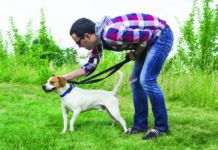In How to Behave So Your Dog Behaves, veterinarian Sophia Yin, DVM, MS, explains that when animal behaviorists talk about the ways dogs learn, they talk about two main types of conditioning: classical conditioning and operant conditioning. What is the difference? Classical conditioning is learning by association. Operant conditioning is learning by trial and error. These two approaches actually guide learning in all animals, including humans. How does it work?
Classical Conditioning
Think of how your dog reacts when you grab the key to the car. If it’s at pretty much the same time every day and it’s because you drive him to the dog park at that time, he will make a bridge in his mind from the jangling of the keys on the chain to the great experience he’s about to have running around with his canine buddies. He will cooperate by coming over to you enthusiastically to have his leash put on. He will have learned by association — not through intentional teaching on your part — that your taking the keys means good things are about to happen.
Now, if your dog has severe separation anxiety, your taking the key at a certain time each day — say, to leave for work — may have an entirely different associative effect, filling him with dread. The key in this case becomes a signal that he is about to be left alone, which frightens him. The way to un-do the association is to engage in what behaviorists call counter-conditioning. One way to do that would be to fill your dog’s Kong with a favorite snack (peanut butter? flavored yogurt?) immediately after picking up the car key. Then your dog would learn to associate the sound of the key not with being left alone but with something delicious, something that will occupy him for a while as you walk out the door. This is an oversimplification, of course. It might take more than a food-filled Kong to get your pet over the hump of separation anxiety. And it might take systematic desensitization — incremental steps in leaving the dog alone, at first for several seconds and gradually building up to more and more time on the other side of the door. But the example illustrates in general how classical conditioning “teaches.”
Operant Conditioning
While classical conditioning happens all the time, every single day, without your even realizing it, operant conditioning is always intentional. The dog consciously learns to repeat behaviors that result in consequences he likes and also not to engage in behaviors followed by consequences he doesn’t like. This is where reinforcement and punishment come into the picture. The best way to increase the behavior you are looking for is via positive reinforcement — adding something to the equation that will motivate the dog to do what you want. The best way to decrease a behavior you don’t like is through negative punishment — subtracting something from the equation that the dog desires, like a favorite toy, or your attention. (Positive punishment — adding something to the learning process, such as hitting or pulling on a choke chain — is something we and respected animal behaviorists don’t condone.)
Let’s say you want to teach your dog to fetch your slippers, for example. It could take a while; you may have to shape the behavior over time. For instance, at first your dog might have to be rewarded simply for going over to the slippers when you give the “Slippers” cue. But each time he moves toward approximating the behavior you desire by following your cue, you provide positive reinforcement by immediately giving warm praise and a delectable treat. It’s a real “classroom” situation, but a fun one, filled with palpable rewards that are better than gold stars.
As for how to apply negative punishment, imagine that you want to teach your dog not to do something, like bark loudly and incessantly every time you go for the leash to take him out. A typical reaction is to yell at the dog, letting him know how annoying this is. But he doesn’t care. He’s getting what he wants, and you’re giving him attention at the same time. Instead, try stopping in your tracks each time he barks. After a number of seconds, he will have to take a break to catch his breath. At those moments, immediately pick up where you left off, whether it’s continuing to take the leash off a peg or resuming putting the collar around his neck. If he starts barking again, stop again. By withholding what he desires, which is to be outside, you are teaching him that it will not happen if he keeps barking during the process of getting ready.
You don’t want to show anger or exasperation. You want to remain very calm, like it’s a neutral thing: barking = not going out.




